A networked rendering paradigm for remote rendering
Abstract: Advances in 3D graphics make it possible to generate highly realistic 3D models
which usually contain a huge number of polygons. This large number of polygons gives rise to
many challenges with respect to real-time rendering performance, storage requirements, and
the transmission of graphics dataset over the network. In this paper, a networked rendering
paradigm based on our pipeline-splitting method is introduced to facilitate the remote
rendering system. Experimental results show that our method can reduce memory cost and
computational workload for the client compared to that of client-side method.

Trang 1
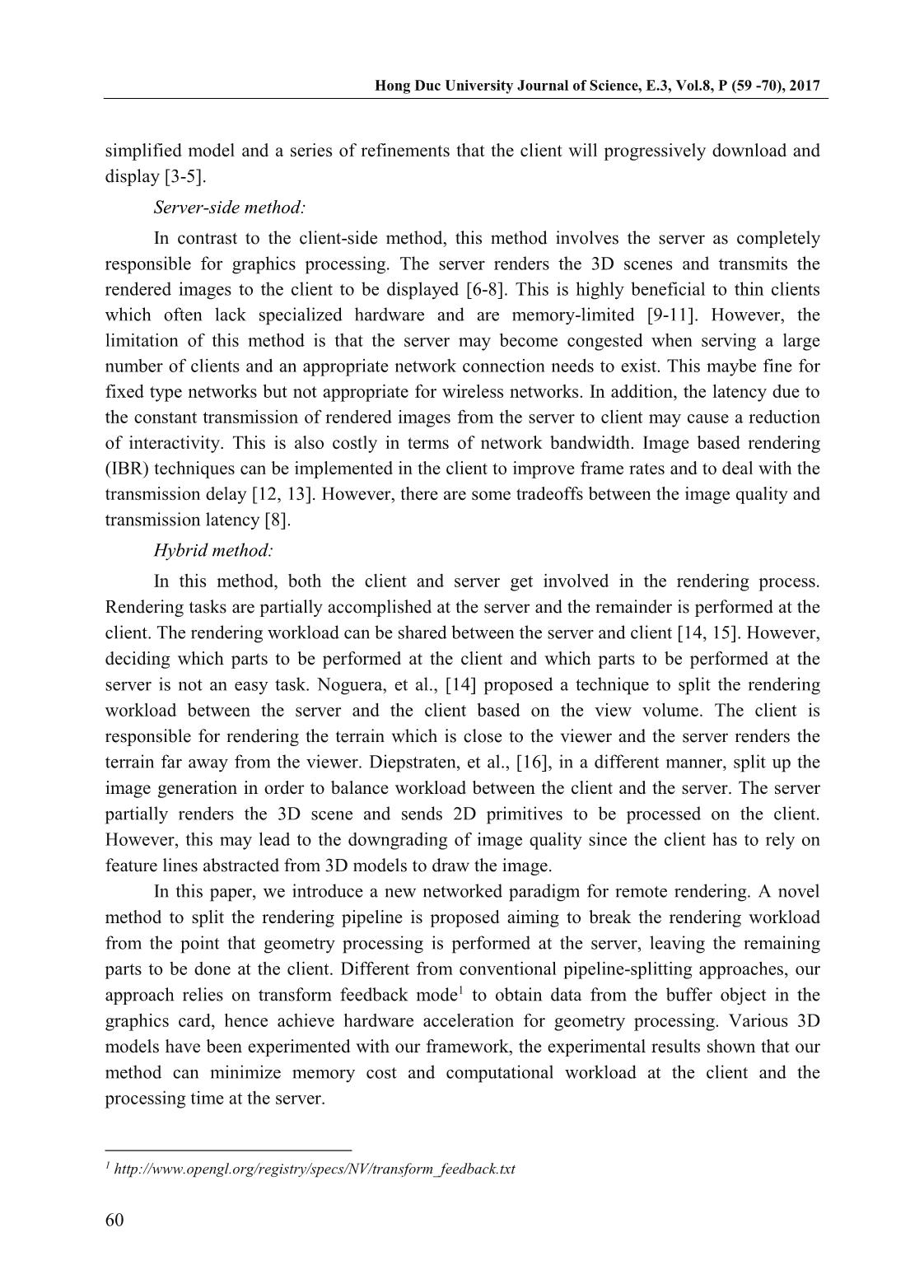
Trang 2
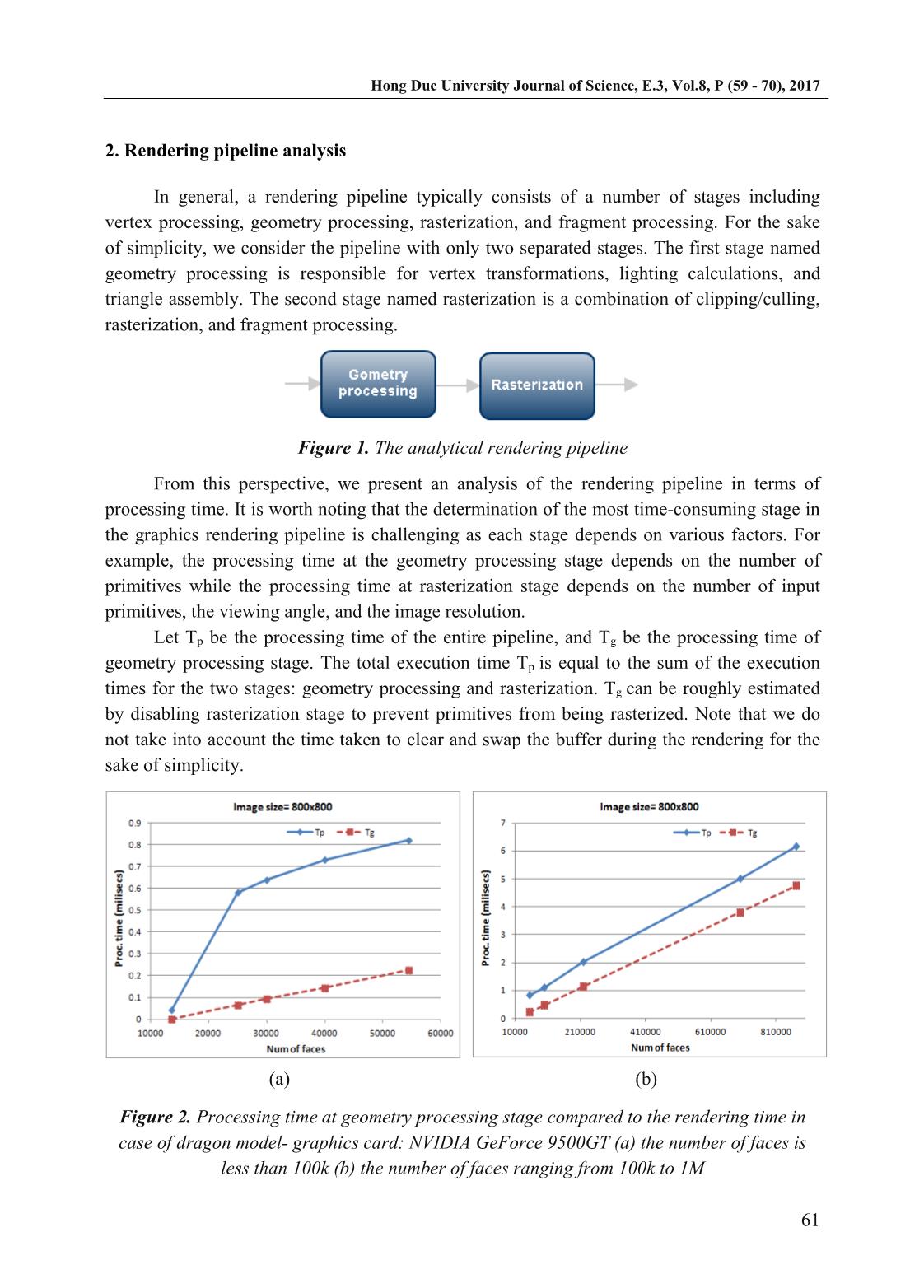
Trang 3
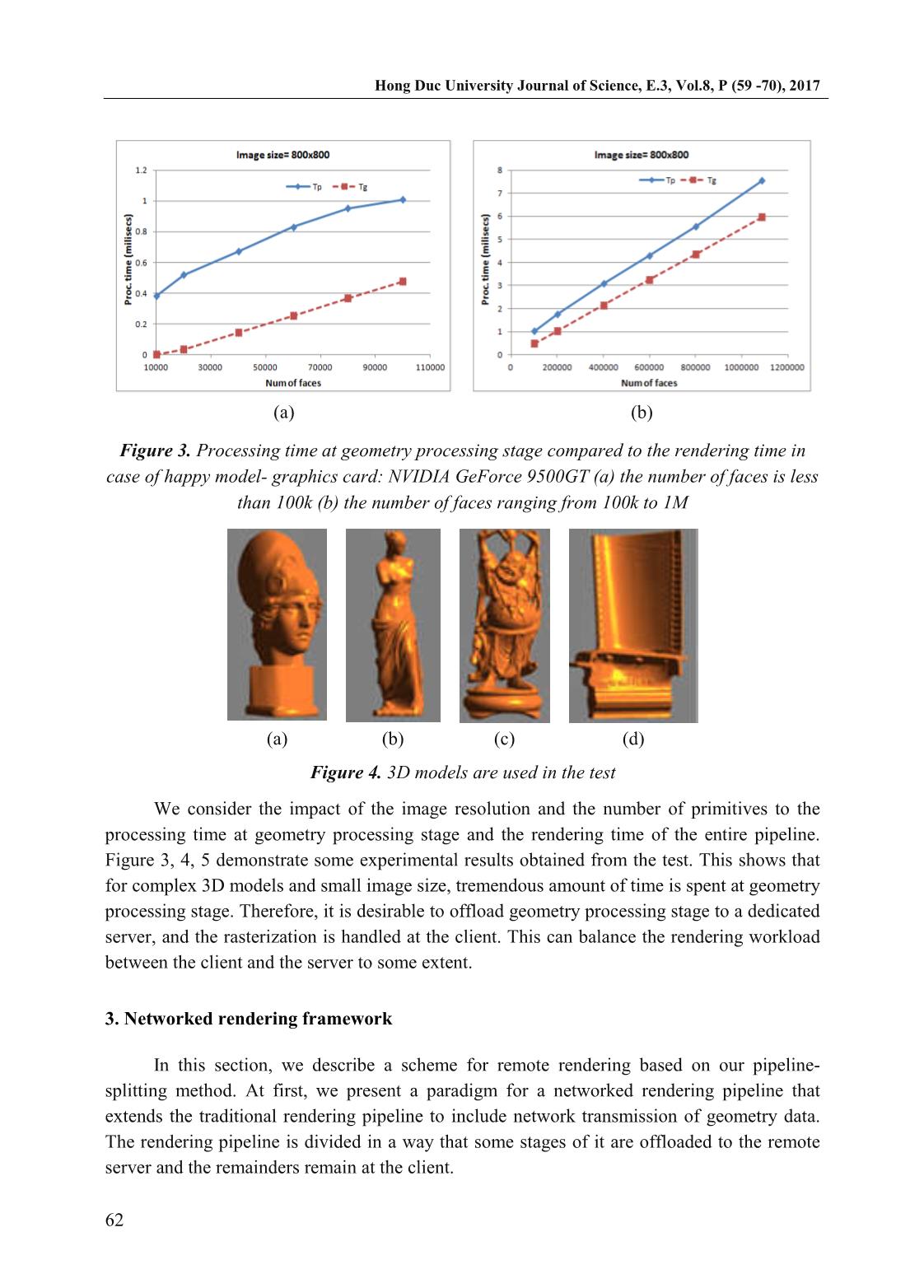
Trang 4
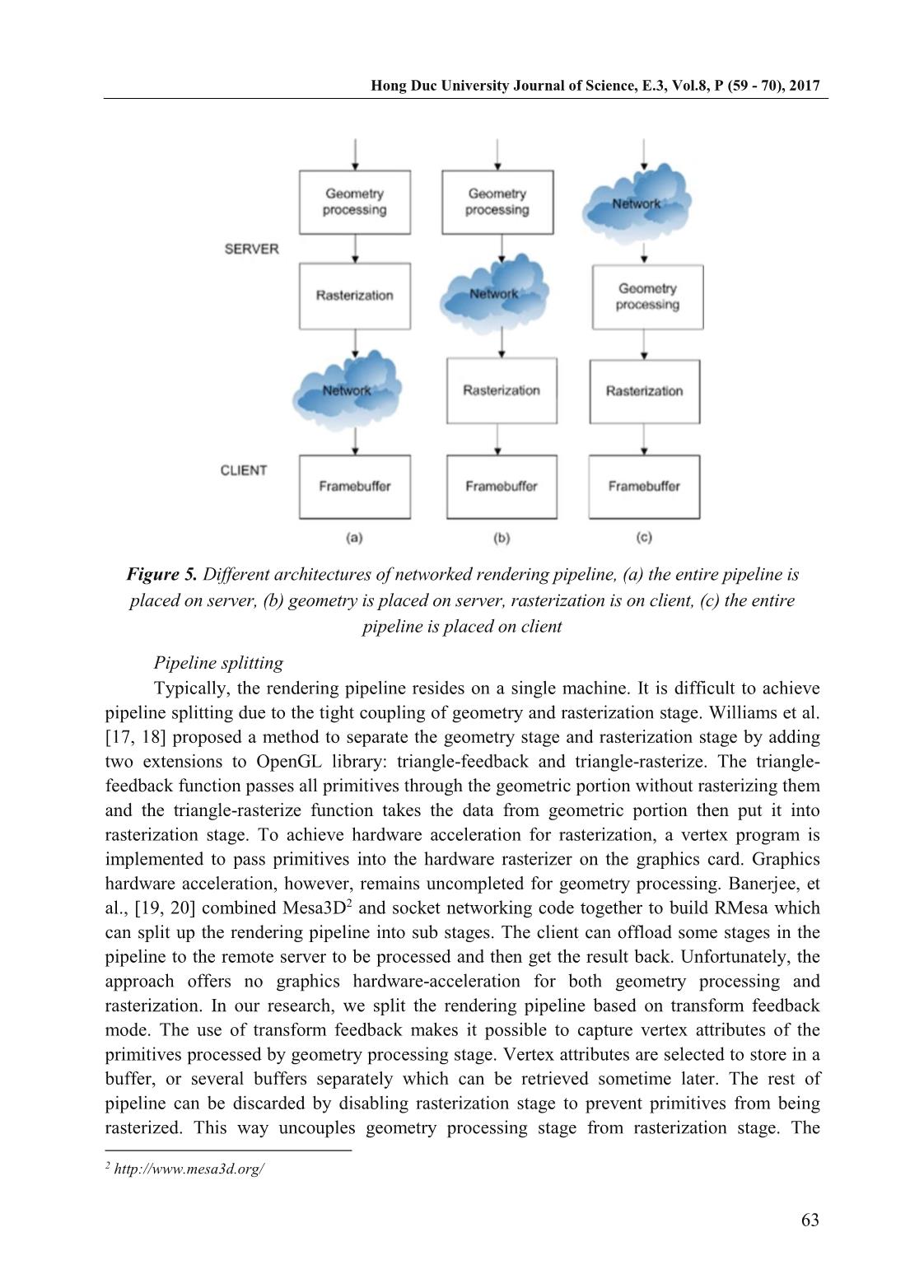
Trang 5
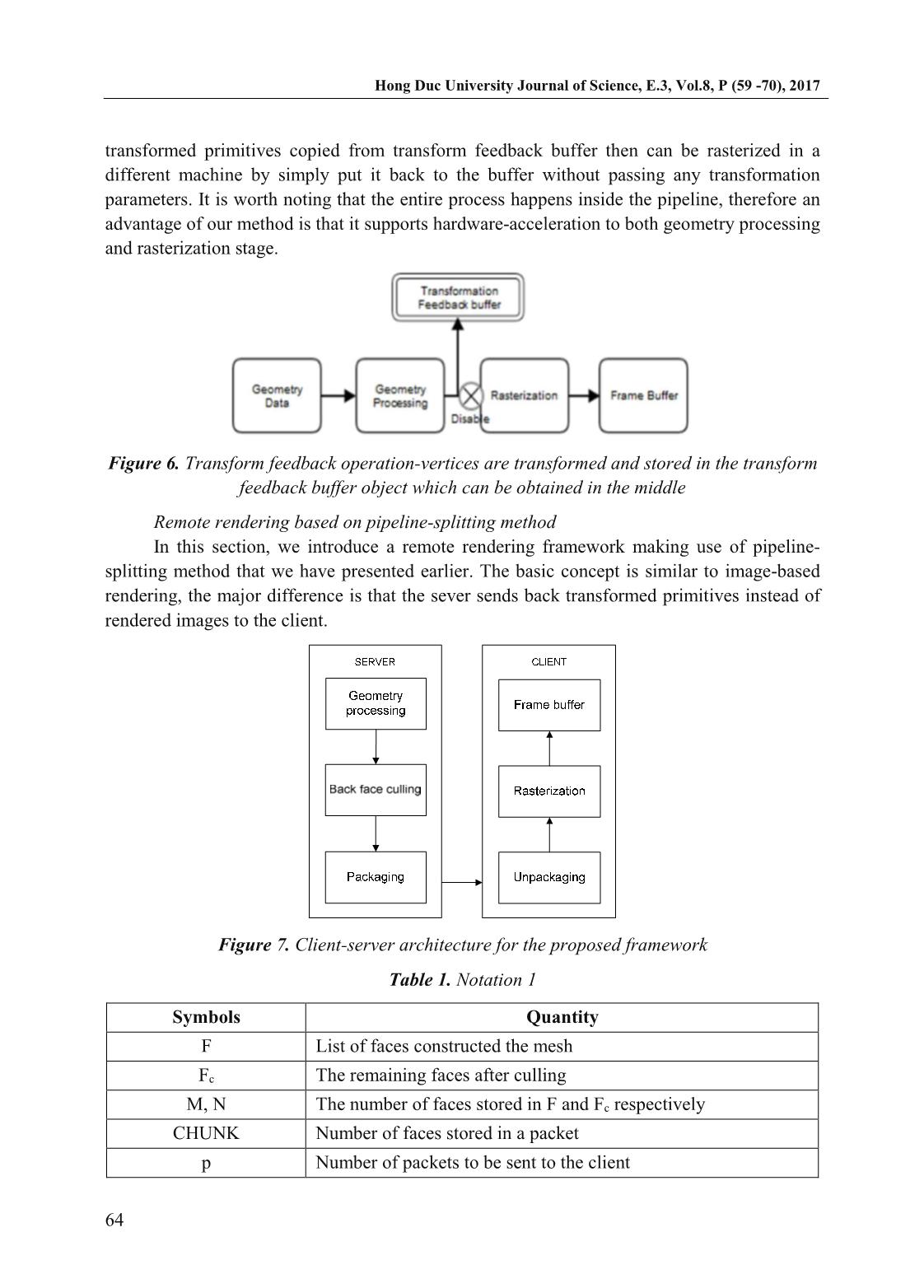
Trang 6
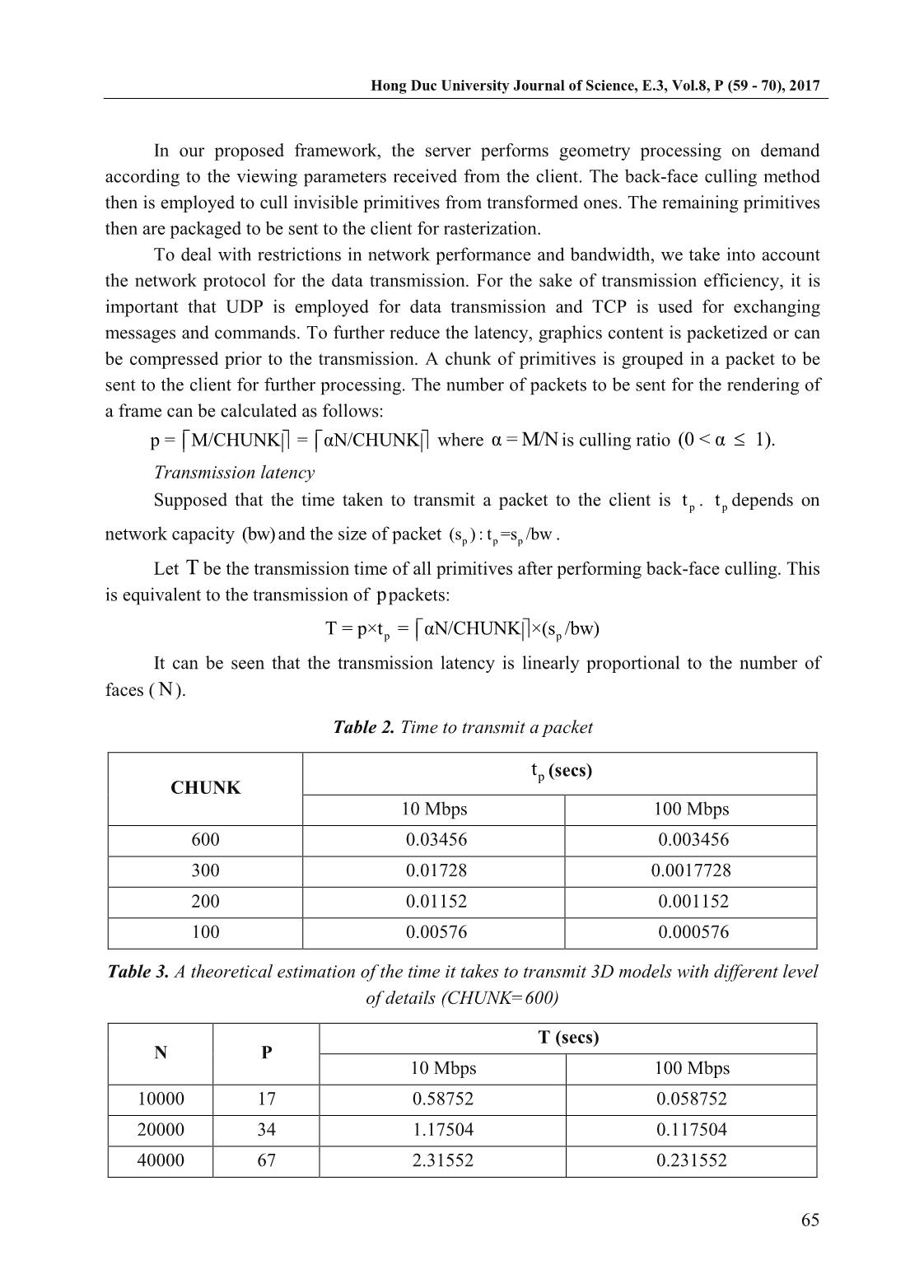
Trang 7
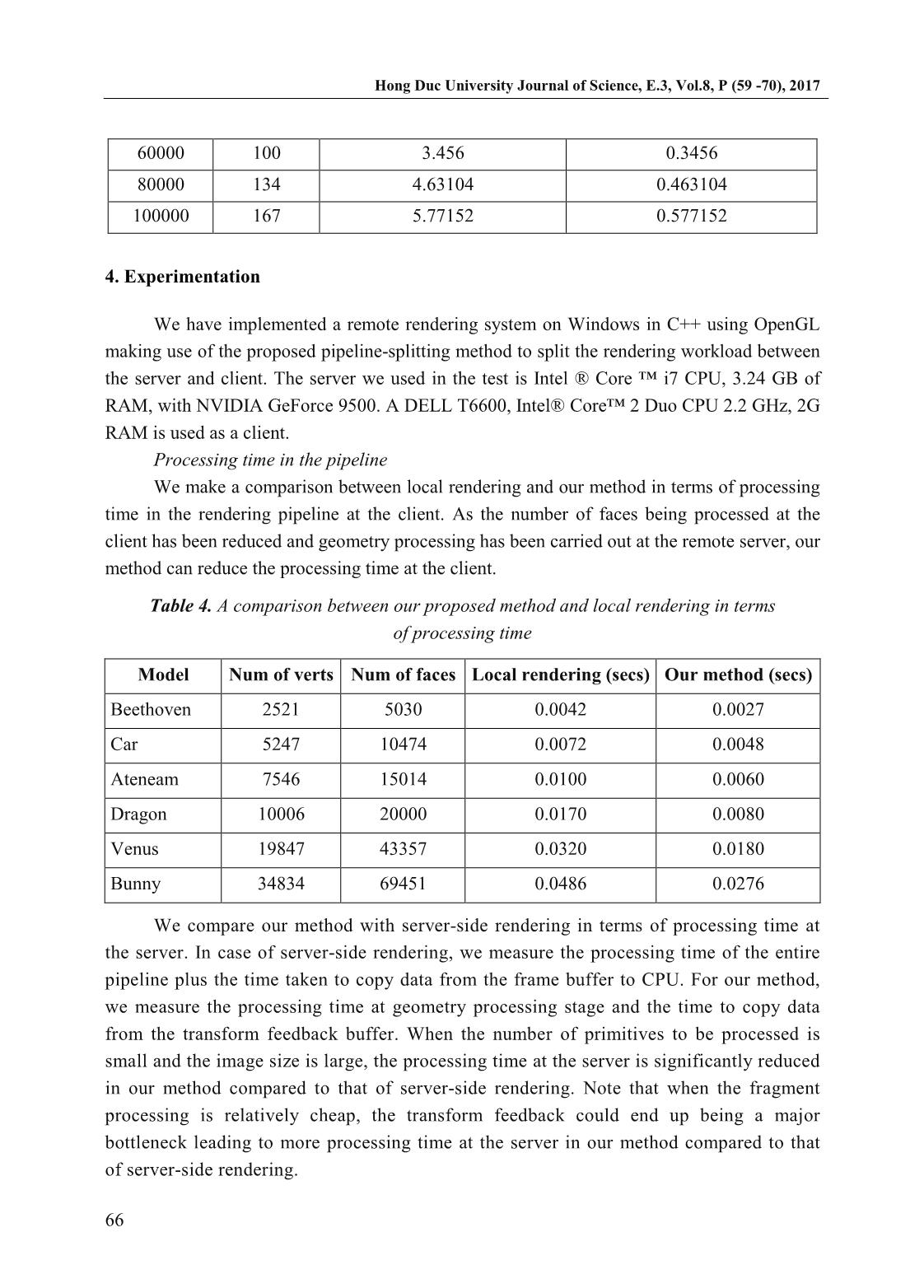
Trang 8

Trang 9
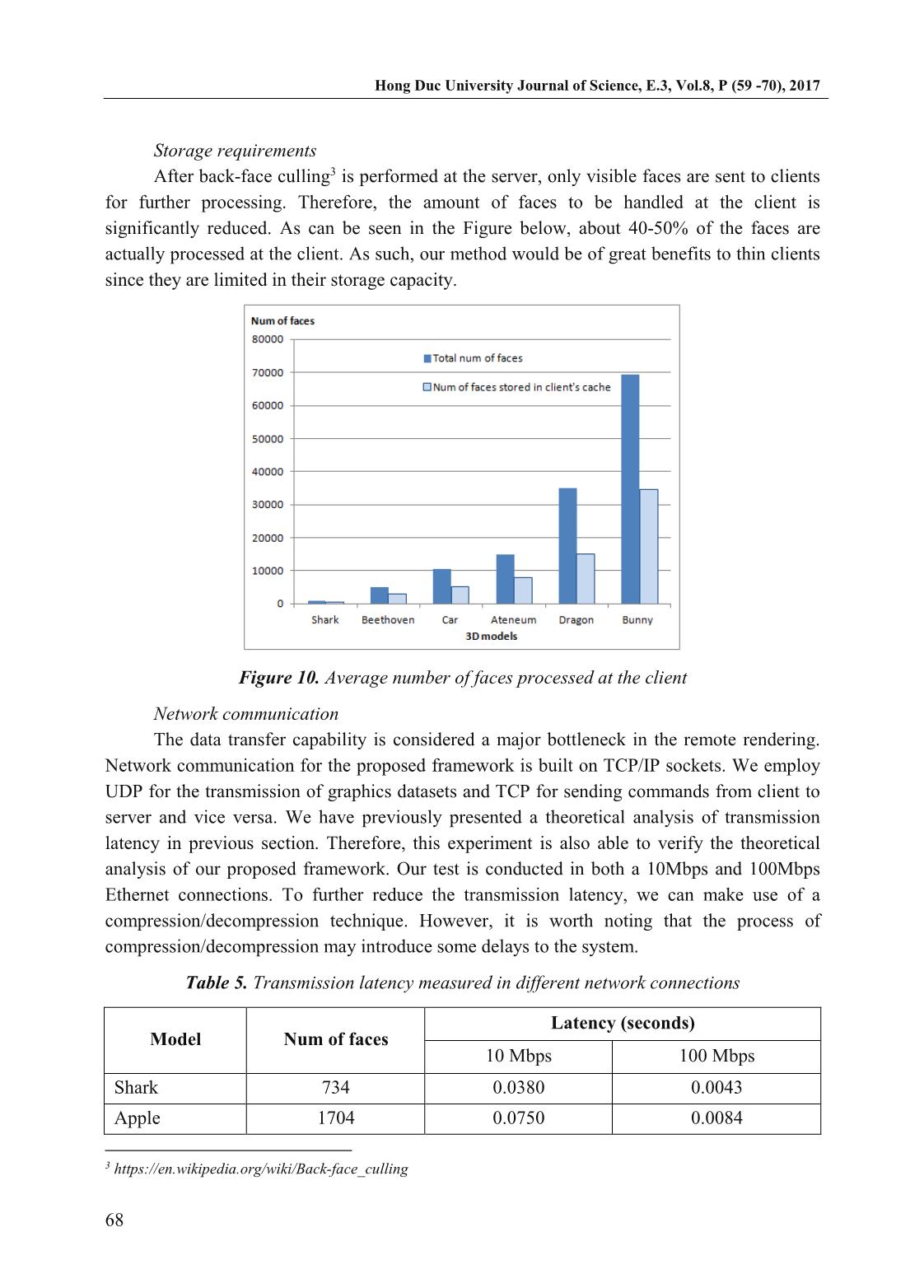
Trang 10
Tải về để xem bản đầy đủ
Bạn đang xem 10 trang mẫu của tài liệu "A networked rendering paradigm for remote rendering", để tải tài liệu gốc về máy hãy click vào nút Download ở trên
Tóm tắt nội dung tài liệu: A networked rendering paradigm for remote rendering
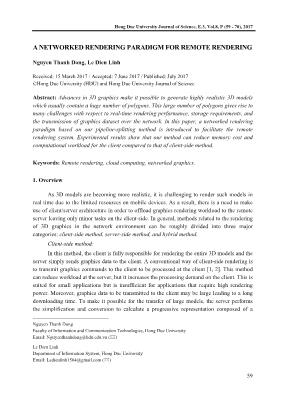
ded to the remote server and the remainders remain at the client. (a) (b) Hong Duc University Journal of Science, E.3, Vol.8, P (59 - 70), 2017 63 Figure 5. Different architectures of networked rendering pipeline, (a) the entire pipeline is placed on server, (b) geometry is placed on server, rasterization is on client, (c) the entire pipeline is placed on client Pipeline splitting Typically, the rendering pipeline resides on a single machine. It is difficult to achieve pipeline splitting due to the tight coupling of geometry and rasterization stage. Williams et al. [17, 18] proposed a method to separate the geometry stage and rasterization stage by adding two extensions to OpenGL library: triangle-feedback and triangle-rasterize. The triangle- feedback function passes all primitives through the geometric portion without rasterizing them and the triangle-rasterize function takes the data from geometric portion then put it into rasterization stage. To achieve hardware acceleration for rasterization, a vertex program is implemented to pass primitives into the hardware rasterizer on the graphics card. Graphics hardware acceleration, however, remains uncompleted for geometry processing. Banerjee, et al., [19, 20] combined Mesa3D2 and socket networking code together to build RMesa which can split up the rendering pipeline into sub stages. The client can offload some stages in the pipeline to the remote server to be processed and then get the result back. Unfortunately, the approach offers no graphics hardware-acceleration for both geometry processing and rasterization. In our research, we split the rendering pipeline based on transform feedback mode. The use of transform feedback makes it possible to capture vertex attributes of the primitives processed by geometry processing stage. Vertex attributes are selected to store in a buffer, or several buffers separately which can be retrieved sometime later. The rest of pipeline can be discarded by disabling rasterization stage to prevent primitives from being rasterized. This way uncouples geometry processing stage from rasterization stage. The 2 Hong Duc University Journal of Science, E.3, Vol.8, P (59 -70), 2017 64 transformed primitives copied from transform feedback buffer then can be rasterized in a different machine by simply put it back to the buffer without passing any transformation parameters. It is worth noting that the entire process happens inside the pipeline, therefore an advantage of our method is that it supports hardware-acceleration to both geometry processing and rasterization stage. Figure 6. Transform feedback operation-vertices are transformed and stored in the transform feedback buffer object which can be obtained in the middle Remote rendering based on pipeline-splitting method In this section, we introduce a remote rendering framework making use of pipeline- splitting method that we have presented earlier. The basic concept is similar to image-based rendering, the major difference is that the sever sends back transformed primitives instead of rendered images to the client. Figure 7. Client-server architecture for the proposed framework Table 1. Notation 1 Symbols Quantity F List of faces constructed the mesh Fc The remaining faces after culling M, N The number of faces stored in F and Fc respectively CHUNK Number of faces stored in a packet p Number of packets to be sent to the client Hong Duc University Journal of Science, E.3, Vol.8, P (59 - 70), 2017 65 In our proposed framework, the server performs geometry processing on demand according to the viewing parameters received from the client. The back-face culling method then is employed to cull invisible primitives from transformed ones. The remaining primitives then are packaged to be sent to the client for rasterization. To deal with restrictions in network performance and bandwidth, we take into account the network protocol for the data transmission. For the sake of transmission efficiency, it is important that UDP is employed for data transmission and TCP is used for exchanging messages and commands. To further reduce the latency, graphics content is packetized or can be compressed prior to the transmission. A chunk of primitives is grouped in a packet to be sent to the client for further processing. The number of packets to be sent for the rendering of a frame can be calculated as follows: p = M/CHUNK = αN/CHUNK where α = M/N is culling ratio (0 < α 1). Transmission latency Supposed that the time taken to transmit a packet to the client is pt . pt depends on network capacity (bw) and the size of packet p p p(s ) : t =s /bw . Let T be the transmission time of all primitives after performing back-face culling. This is equivalent to the transmission of ppackets: p pT = p×t = αN/CHUNK ×(s /bw) It can be seen that the transmission latency is linearly proportional to the number of faces ( N). Table 2. Time to transmit a packet CHUNK pt (secs) 10 Mbps 100 Mbps 600 0.03456 0.003456 300 0.01728 0.0017728 200 0.01152 0.001152 100 0.00576 0.000576 Table 3. A theoretical estimation of the time it takes to transmit 3D models with different level of details (CHUNK=600) N P T (secs) 10 Mbps 100 Mbps 10000 17 0.58752 0.058752 20000 34 1.17504 0.117504 40000 67 2.31552 0.231552 Hong Duc University Journal of Science, E.3, Vol.8, P (59 -70), 2017 66 60000 100 3.456 0.3456 80000 134 4.63104 0.463104 100000 167 5.77152 0.577152 4. Experimentation We have implemented a remote rendering system on Windows in C++ using OpenGL making use of the proposed pipeline-splitting method to split the rendering workload between the server and client. The server we used in the test is Intel ® Core ™ i7 CPU, 3.24 GB of RAM, with NVIDIA GeForce 9500. A DELL T6600, Intel® Core™ 2 Duo CPU 2.2 GHz, 2G RAM is used as a client. Processing time in the pipeline We make a comparison between local rendering and our method in terms of processing time in the rendering pipeline at the client. As the number of faces being processed at the client has been reduced and geometry processing has been carried out at the remote server, our method can reduce the processing time at the client. Table 4. A comparison between our proposed method and local rendering in terms of processing time Model Num of verts Num of faces Local rendering (secs) Our method (secs) Beethoven 2521 5030 0.0042 0.0027 Car 5247 10474 0.0072 0.0048 Ateneam 7546 15014 0.0100 0.0060 Dragon 10006 20000 0.0170 0.0080 Venus 19847 43357 0.0320 0.0180 Bunny 34834 69451 0.0486 0.0276 We compare our method with server-side rendering in terms of processing time at the server. In case of server-side rendering, we measure the processing time of the entire pipeline plus the time taken to copy data from the frame buffer to CPU. For our method, we measure the processing time at geometry processing stage and the time to copy data from the transform feedback buffer. When the number of primitives to be processed is small and the image size is large, the processing time at the server is significantly reduced in our method compared to that of server-side rendering. Note that when the fragment processing is relatively cheap, the transform feedback could end up being a major bottleneck leading to more processing time at the server in our method compared to that of server-side rendering. Hong Duc University Journal of Science, E.3, Vol.8, P (59 - 70), 2017 67 Figure 8. A comparison between server-side rendering and our method in terms of processing time tested with dragon model Figure 9. A comparison between server-side rendering and our method in terms of processing time tested with happy model Hong Duc University Journal of Science, E.3, Vol.8, P (59 -70), 2017 68 Storage requirements After back-face culling3 is performed at the server, only visible faces are sent to clients for further processing. Therefore, the amount of faces to be handled at the client is significantly reduced. As can be seen in the Figure below, about 40-50% of the faces are actually processed at the client. As such, our method would be of great benefits to thin clients since they are limited in their storage capacity. Figure 10. Average number of faces processed at the client Network communication The data transfer capability is considered a major bottleneck in the remote rendering. Network communication for the proposed framework is built on TCP/IP sockets. We employ UDP for the transmission of graphics datasets and TCP for sending commands from client to server and vice versa. We have previously presented a theoretical analysis of transmission latency in previous section. Therefore, this experiment is also able to verify the theoretical analysis of our proposed framework. Our test is conducted in both a 10Mbps and 100Mbps Ethernet connections. To further reduce the transmission latency, we can make use of a compression/decompression technique. However, it is worth noting that the process of compression/decompression may introduce some delays to the system. Table 5. Transmission latency measured in different network connections Model Num of faces Latency (seconds) 10 Mbps 100 Mbps Shark 734 0.0380 0.0043 Apple 1704 0.0750 0.0084 3 https://en.wikipedia.org/wiki/Back-face_culling Hong Duc University Journal of Science, E.3, Vol.8, P (59 - 70), 2017 69 Ant 912 0.0380 0.0044 Beethoven 5030 0.1778 0.0199 Car 10474 0.3432 0.0337 Ateneam 15014 0.3840 0.0469 Big dodge 16646 0.5261 0.0543 Dragon 1 20000 0.6247 0.0641 Dragon 2 35000 1.0741 0.1117 Venus 43357 1.2881 0.1359 Bunny 69451 2.1737 0.2124 5. Conclusion In this paper, we have investigated the graphics rendering pipeline in terms of processing time. We have proposed a networked rendering paradigm based on our pipeline- splitting method to facilitate remote rendering. It is shown that our method can reduce memory cost and computational workload at the client compared to that of client-side rendering and processing time at the server compared to that of server-side rendering. The work also can be applied to distributed-rendering as we can distribute geometry processing and rasterization to be handled on different machines in the cloud. It is worth noting that our framework can work with pretty large 3D models, however, there must be a limit since the residual list is linearly proportional to the number of faces of the 3D model. References [1] G. Jung and S. Jung (2006), A Streaming Engine for PC-Based 3D Network Games onto Heterogeneous Mobile Platforms, in Technologies for E-Learning and Digital Entertainment. vol. 3942, Z. Pan, R. Aylett, H. Diener, X. Jin, S. Göbel, and L. Li, Eds., ed: Springer Berlin / Heidelberg, pp. 797-800. [2] A. Mohr and M. Gleicher (2002), HijackGL: reconstructing from streams for stylized rendering, presented at the Proceedings of the 2nd international symposium on Non- photorealistic animation and rendering, Annecy, France, pp.13-ff. [3] G. Hesina and D. Schmalstieg (1998), A Network Architecture for Remote Rendering, presented at the Proceedings of the Second International Workshop on Distributed Interactive Simulation and Real-Time Applications, pp.88. [4] M. Isenburg and P. Lindstrom (2005), Streaming meshes, in Visualization, 2005. VIS 05. IEEE, 2005, pp. 231-238. [5] H. T. Vo, S. P. Callahan, P. Lindstrom, V. Pascucci, and C. T. Silva (2007), Streaming Simplification of Tetrahedral Meshes, Visualization and Computer Graphics, IEEE Transactions on, vol. 13, pp. 145-155. Hong Duc University Journal of Science, E.3, Vol.8, P (59 -70), 2017 70 [6] X. Liu, H. Sun, and E. Wu (2000), A hybrid method of image synthesis in IBR for novel viewpoints, presented at the Proceedings of the ACM symposium on Virtual reality software and technology, Seoul, Korea. [7] Z. J. Y. Lei, D. Chen, and H. Bao (2004), Image-Based Walkthrough over Internet on Mobile Devices, in Proc. GCC Workshops, pp. 728-735. [8] Y. a. C.-O. Mann, D. (1997), Selective Pixel Transmission for Navigating in Remote Virtual Environments, Eurographics '97, Volume 16, Number 3. [9] A. Boukerche, T. Huang, and R. W. N. Pazzi (2005), A real-time transport protocol for image-based rendering over heterogeneous wireless networks, presented at the Proceedings of the 8th ACM international symposium on Modeling, analysis and simulation of wireless and mobile systems, Montral, Quebec, Canada. [10] A. Boukerche, F. Jing, and R. B. de Araujo (2006), A 3D image-based rendering technique for mobile handheld devices, in World of Wireless, Mobile and Multimedia Networks, International Symposium, pp. 7 pp.-331. [11] F. Lamberti and A. Sanna (2007), A Streaming-Based Solution for Remote Visualization of 3D Graphics on Mobile Devices, Visualization and Computer Graphics, IEEE Transactions on, vol. 13, pp. 247-260. [12] P. Bao and D. Gourlay (2003), Low bandwidth remote rendering using 3D image warping, in Visual Information Engineering, 2003. VIE 2003. International Conference on, 2003, pp. 61-64. [13] P. Bao and D. Gourlay (2006), A framework for remote rendering of 3-D scenes on limited mobile devices, Multimedia, IEEE Transactions on, vol. 8, pp. 382-389. [14] J. M. Noguera, R. J. Segura, C. J. Ogáyar, and R. Joan-Arinyo (2011), Navigating large terrains using commodity mobile devices, Computers & Geosciences, vol. 37, pp. 1218-1233, 2011. [15] M. Levoy (1995), Polygon-assisted JPEG and MPEG compression of synthetic images, presented at the Proceedings of the 22nd annual conference on Computer graphics and interactive techniques. [16] J. Diepstraten, M. Gorke, and T. Ertl (2004), Remote Line Rendering for Mobile Devices, presented at the Proceedings of the Computer Graphics International. [17] J. L. Williams and R. E. Hiromoto (2005), Sort-middle multi-projector immediate-mode rendering in Chromium, in Visualization. VIS 05. IEEE, 2005, pp. 103-110. [18] J. L. Williams and R. E. Hiromoto (2003), A proposal for a sort-middle cluster rendering system, in Intelligent Data Acquisition and Advanced Computing Systems: Technology and Applications, 2003. Proceedings of the Second IEEE International Workshop on, 2003, pp. 36-38. [19] K. S. Banerjee and E. Agu (2005), Remote execution for 3D graphics on mobile devices, in Wireless Networks, Communications and Mobile Computing, International Conference on, 2005, pp. 1154-1159 vol.2. [20] E. Agu, B. Kutty, N. Shirish, O. Rekutin, and D. Kramer (2005), A middleware architecture for mobile 3D graphics, in Distributed Computing Systems Workshops. 25th IEEE International Conference on, 2005, pp. 617-623.
File đính kèm:
 a_networked_rendering_paradigm_for_remote_rendering.pdf
a_networked_rendering_paradigm_for_remote_rendering.pdf

